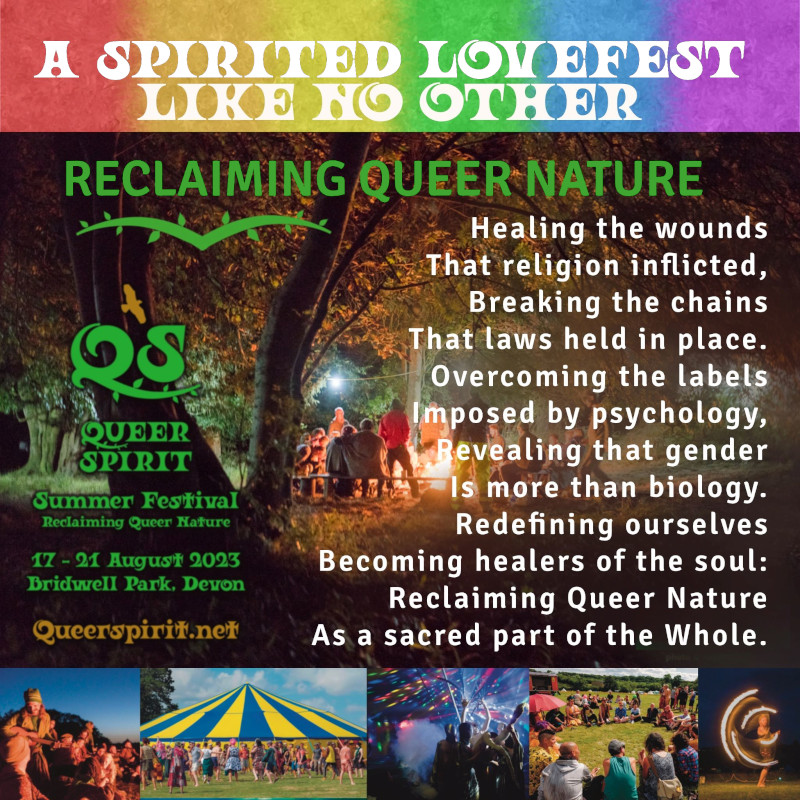The Queer Search For Meaning
The scientific-sociological categories assigned to gender-fluid and same-sex attracted people from the late 19th century didn't sit well with some gay folk of the time. The term homosexual was coined by Hungarian writer Karl Maria Benkert, in correspondence in Germany with Karl Heinrich Ulrichs, the most prominent gay rights campaigner of the time. Use of 'homosexual' in his book Psychopathia Sexualis, by Richard von Krafft-Ebing (1886) led to it becoming the standard term.
Ulrichs, however, preferred a more mystical name - Urning, which became Uranian in English, a reference to Greek Goddess Aphrodite Urania, who is named as the patron of same sex love in Plato's Symposium. The planet Uranus had only recently been discovered, and given the name of the God of Heaven who was castrated and usurped by his son Chronus (Saturn)– the testicles of Uranus merging with the ocean to give birth to the goddess of love, Aphrodite. Edward Carpenter and other British intellectuals adopted Uranian because their personal experience of their own nature was that is was less about 'sexuality' than it was about LOVE. Oscar Wilde wrote in a letter in 1898: “To have altered my life would have been to have admitted that Uranian love is ignoble. I hold it to be noble—more noble than other forms.” In North America the Calamus poems of Walt Whitman simply celebrated 'the manly love of comrades.'
Sapphic and lesbian became common terms for love between women from the 1730s, at a time when gay men were mostly called sodomites, though gay men themselves used other words including mollies and ganymedes, both terms with roots in the ancient Greek and Roman empires, where same sex love was held in much higher regard. Tribadism is an ancient term for female same sex love, and was still in frequent use until lesbian became the norm in the 19th century. There is nothing new about gay or queer identities, but the effort to define the 'purpose' of them is a modern obsession, felt strongly by those of us who wish to overturn the centuries of lies and hatred.
Other terms floating around in the early 20th century for queers included 'intermediate types' or 'inverts,' but from the 1890s at least there were gay men in cities such as New York preferring to call themselves 'faeries,' as George Chauncey has documented in Gay New York: Gender, Culture, and the Making of the Gay Male World, 1890–1940. Chauncey says that many effeminate men embraced the fairy identity because “it embodied a way of understanding how they, as men, could have feelings their culture ascribed exclusively to women.” Same-sex love was sometimes called adhesive love, Wilde called it 'the love that dare not speak its name', which perhaps inspired John Henry Mackay, son of a Scottish marine insurance broker and a German mother, to title his work appealing for gay emancipation, published in Germany in 1913 under the pseudonym Sagitta, 'The Books of Nameless Love.'
Edward Carpenter believed that once gay people were free to love without fear or judgement, they would become teachers of love and consciousness: “This interaction in fact between the masculine and the feminine, this mutual illumination of logic and meditation, may not only raise and increase the power of each of these faculties, but it may give the mind a new quality, and a new power of perception corresponding to the blending of subject and object in consciousness. It may possibly lead to the development of that third order of perception which has been called the cosmic consciousness and which may also be termed divination.” Intermediate types among primitive folks, 1913
In Gay Men of Wisdom: A Group Centered Approach to Helping Gay Men Value Their Distinct Gifts (2018), Raymond L. Rigoglioso writes:
“For more than a century, there has been a tradition among gay men of exploring the meaning and purpose of being gay." This tradition involves an extensive literature, dating back to Edward Carpenter’s seminal 1908 book The Intermediate Sex, Donald Webster Cory’s The Homosexual in America in 1951, and Mark Thompson’s (1987, 1994, 1997) influential trilogy Gay Spirit, Gay Soul, and Gay Body....
“In 1999, Christian de la Huerta published Coming Out Spiritually and formed Q-Spirit, an international network of gays and lesbians in spirituality. Toby Johnson, author of numerous books on gay spirituality, including one by that very title (Johnson, 2004), led groups in Austin, Texas, toward a similar purpose. In 2002, David Nimmons published The Soul Beneath the Skin: The Unseen Hearts and Habits of Gay Men and formed the nonprofit Manifest Love, which, in addition to staging “loving disturbances,” gathered gay men in workshops around the country to explore their natures. From the beginning—for reasons that still puzzle this author—this inquiry has taken place on the margins of the community of men-who-love-men. Even Harry Hay found himself the focus of resistance in the Mattachine Society for his emphasis on cultural transformation and, for several reasons, was forced to leave...”
Raymond goes on to comment:
“To my knowledge (I welcome the opportunity to be proven wrong), lesbians, bisexuals, and transgender people have not developed narratives of social purpose. Some might argue that the existing literature includes L, B, and T people, but a closer look reveals otherwise: All of the books in the genre, with the exception of Another Mother Tongue: Gay Words, Gay Worlds, written by Judy Grahn in 1984, have been written by gay men. Most of the examples and discussion in the genre pertain to gay men. To say the genre includes other identities within the LGBT umbrella is disingenuous.
“I had the fortune to meet Grahn in 2016 on a trip to the Bay Area, and we discussed this phenomenon. She acknowledged that lesbians likely do not have such a narrative—that no books have been published on the subject, and that if anything has been written, it might have been published in small, independent magazines. Grahn hypothesized that, for lesbians, distinguishing their differences from straight women might cause rifts among women committed to feminism and equality. Maintaining bonds of sisterhood among all women might be a higher priority.
“Gay men, however, have no such luxury. Being marginalized among men, as well as by the larger society, leaves those with the self-awareness and willingness to engage in reflection with no choice but to ponder Hay’s original questions. I have always believed that this inquiry has incredible potential to transform not just gay men but all human beings. If gay men can institutionalize this kind of questioning, we can provide a model for all people about how to value human differences.”
Harry Hay (1912-2002) was a founder of the Mattachine Society campaigning for gay rights in 1950s USA and of the (now global) Radical Faerie Community in the late 1970s. For decades Hay called on queer people to reclaim our spiritual roots:
“It is time for us to reject the lie by which Organised Religions have attempted to obliterate us for two millennia. Sexual Orientation isn't the only difference between Us and the Heteros. As a result of the way we had been malignantly demeaned and diminished over the centuries, it is the only difference LEFT between US and the Heteros. It is time we took a leaf from the lessons Third Gender Brothers in other cultures have to teach us in how to re-earn the respect and gratitude of our Hetero Communities for the Different people that we are – as well as for the talents and gifts we bring to share.”
Many traditional cultures around the world recognised more than two genders, and frequently considered third-gender people as having specific qualities, for which they were highly regarded. Hay wrote about:
“...our capacities as Mediators through History – in cultures around the world as diverse as the ancient Sumerians in the valleys of the Tigris and Euphrates, the Neolithic as well as the Barbarian Celts of the Danube and Rhine Valleys, the Achaeans of Macedonia, the Dyaks of Borneo, the Arabs of 19th and 20th century Morocco, and the Navaho of yesterday's and today's Arizona...
… MEDIATORS between the seen and unseen - as Berdache Priests and Shaman Seers, as artists and architects, as Scientists, as Teachers, and as Designers of the possible;
… MEDIATORS between the make-believe and the real – through Theatre and Music and Dance and Poetry;
… MEDIATORS between the Spirit and the flesh – as Teachers and Healers and Counsellors and Therapists.”
Hay proposed that western gays take “a hand-up example from our potential allies” in other cultures, and went as far as to suggest:
“...that we Gay Men of all colours prepare to present ourselves as the gentle non-competitive Third Gender men of the Western World with whole wardrobes and garages crammed with cultural and spiritual contributions to share.”
One of those talents, as identified by Hay, is gay men's capacity for what he called subject-SUBJECT Consciousness, the natural occurrence of what Edward Carpenter had called a “new power of perception corresponding to the blending of subject and object in consciousness.”
Hay wrote:
“The way out of our comprehensional stalemate, the quagmire into which the Binary inheritances of our brain-training and our cultural superstructure have hurled us.... Humanity must expand its experience to thinking of another, that other, not as object – to be used, to be manipulated, to be mastered, to be consumed – but as subject, as another like him/her self, another self to be respected, to be appreciated, to be cherished.”
He called out: “Brothers and Sisters, isn't it about time we started to tell our parent Society who we really are? Isn't it about time we helped them to understand that rather than being merely a sexual variation of them, in all other senses exactly the same of they, we are a Separate People with, in several measurable respects, a rather different window on the world, a different consciousness, which may be triggered into being by our lovely sexuality?”
But Hay understood there was a hurdle to overcome:
“...before we can do that, before we can tell them who we are, we shall have to begin telling each other. Up to now it's been easier to march in the streets and scream and holler than it has been to sit in a circle and examine and evaluate. It's been easier to pretend we're really almost the same as everyone else, although we don't fool the Heteros for a minute, than it is to dig and dig into the bicameral subterranean channels of collective memory – a cataloguing and a collecting we've been avoiding like the plague....
“Our lovely and talented Gay Community with an enormous 100,000 year history of discovery and largely selfless contribution, our Minority of Ducks-in-whatever-henhouse-of-Chickens-they-were-inadvertently-born-into knows that we as a Separate People comprise a total deviation of consciousness that is not to be reduced by the nasty sexual drooling of dirty legalistic inferior minds.” From speech at 1986 March on Washington
The quest for spiritual understanding of TRANS nature has actually been underway for some time too, in the work of people like Kate Bornstein (Gender Outlaw: On Men, Women, and the Rest of Us ), Lesley Feinberg (Transgender Warriors: Making History from Joan of Arc to Dennis Rodman) and Raven Kaldera, who in their epic work Hermaphrodeities, says
“Transgendered people have long been robbed of their own spiritual history, not knowing that there were once times and places where ours was considered a spiritual path in and of itself. This book explores both our spiritual history and our modern predicaments, shaping the outline of a contemporary spiritual path for those of us who don't fit into just one gender box... Hermaphrodeities features third gender myths, deities, personal and group exercises, community service project suggestions, rituals, and interviews with people from all over both the transgender spectrum. We are all sacred and it is time that the world knew it.”
In the late 19th century Edward Carpenter had also had a sense of the long, mysterious, hidden journey of queer nature through history, and it's true spiritual qualities. In his collection of mystical poetry 'Towards Democracy' he left us this gem:
O Child of Uranus
O child of Uranus, wanderer down all times,
Darkling, from farthest ages of the Earth the same
Strange tender figure, full of grace and pity,
Yet outcast and misunderstood of men-
Thy Woman-soul within a Man's form dwelling,
[Was Adam perchance like this, ere Eve from his side was
drawn?]
So gentle, gracious, dignified, complete,
With man's strength to perform, and pride to suffer without sign,
And feminine sensitiveness to the last fibre of being;
Strange twice-born, having entrance to both worlds-
Loved, loved by either sex,
And free of all their lore!
I see thee where down all of Time thou comest;
And women break their alabaster caskets, kiss and anoint thy
feet, and bless the womb that bare thee,
While in thy bosom with thee, lip to lip,
Thy younger comrade lies.
Lord of the love which rules this changing world,
Passing all partial loves, this one complete - the Mother love
and sex emotion blended-
I see thee where for centuries thou hast walked,
Lonely, the world of men
Saving, redeeming, drawing all to thee,
Yet outcast, slandered, pointed of the mob,
Misjudged and crucified.
Dear Son of heaven - long suffering wanderer through the
wilderness of civilisation-
The day draws nigh when from these mists of ages
Thy form in glory clad shall reappear.
Once the homophobic lies of religion are rejected and the spiritual dimension of human consciousness is accepted and addressed, the sacred aspects of queer nature start to shine forth . This has an effect on material reality too - The Gay Liberation Movement of the 1970s had a strong sense of purpose – the GLF manifesto called for the dismantling of rigid gender roles and the oppression of the nuclear family. Queers question and challenge the rigid norms of society, and have long explored communal ways of living - from ancient times in temples, medieval monasteries, theatrical groups, and more recently in radical faerie sanctuaries.
Christian de la Huerta calls us 'scouts of consciousness,' one of the many identifiable roles queer people play in society. His full list (from Coming Out Spiritually): 1) Catalytic Transformers: A Taste for Revolution, 2) Outsiders: Mirroring Society, 3) Consciousness Scouts: Going First and Taking Risks, 4) Sacred Clowns and Eternal Youth: A Gay, Young Spirit, 5) Keepers of Beauty: Reaching for the Sacred, 6) Caregivers: Taking Care of Each Other, 7) Mediators: The In-between People, 8) Shamans and Priests: Sacred Functionaries, 9) The Divine Androgyne: An Evolutionary Role?, 10) Gatekeepers: Guardians of the Gates.
Queer people are born to explore new territories of love, joy, pleasure and community, and by so doing push the evolution of the species forwards. But first we have to liberate ourselves from the deeply rooted oppression that has been going on for many dark centuries and is still so painfully alive still in the world today. Knowing our history is key to this – and sharing it with each other so that we might be empowered to live, love and enjoy our queer nature in its divine fullness.

Several hundred queer folk will be gathering in Devon, UK, this summer (August 17-21) to explore and celebrate queer spirituality, magic and reclaim queer nature in all its magical, healing potential. Come join us! Check us out at queerspirit.net



